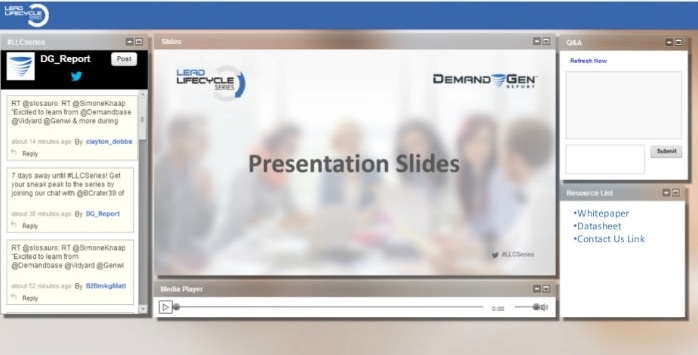 The B2B buyer’s journey is fluid and progressive marketing teams are leveraging tactics such as account-based marketing (ABM) and predictive analytics to provide relevant and resonant content to prospects at any stage of the sales funnel.
The B2B buyer’s journey is fluid and progressive marketing teams are leveraging tactics such as account-based marketing (ABM) and predictive analytics to provide relevant and resonant content to prospects at any stage of the sales funnel.
These were some of the insights shared during the 2015 Lead LifeCycle Series. Roughly 1,400 marketing and sales professionals registered for the week-long event, designed to provide educational content to help B2B organizations enhance their marketing initiatives throughout the buying journey — from initial brand awareness to advocacy. The series also generated considerable social chatter, reaching more than half a million people over the course of the week.
In one popular session, Demandbase‘s John Dering highlighted that is has become more difficult to effectively nurture prospects due to the changing nature of the funnel, he said.
“We’ve seen the funnel in many different shapes and forms,” Dering noted. “Now, funnels are no longer linear — making it difficult for marketers to walk these prospects through their journey.”
The fact that B2B buyers are educating themselves through more channels adds to the challenge. Amanda Halle, Senior Marketing Manager for Demand Generation at LinkedIn Marketing Solutions, highlighted how multiple buyers within accounts and the nonlinear buying journey impact marketing effectiveness.
“Today’s buyer’s journey is, at its core, very unpredictable,” Halle noted. “There are often multiple people involved in the buying decision and they are accessing different channels, which complicates the buyer’s journey.”
Halle educated attendees on how a multichannel nurturing approach can engage prospects earlier in the funnel to maximize conversions. “With longer buying cycles today, [marketers] need to get their brands in front of prospects earlier and more often to create demand. The more interest we drive at the top of the funnel, the more conversion marketers will see at the bottom of the funnel.”
Dering stressed the need to continuously identify and target anonymous buyers. “It comes back to the idea of the ‘always-on’ campaign. You can never lose the opportunity to be in front of a prospect before they raise their hand.”
The key is to have the messaging ready and available to them over an extended period of time, Dering said. “The value proposition can stay the same, but you change how it’s presented to make sure it continuously resonates with prospects at the right time — through the right channel.”
Measuring campaign performance is critical to understanding whether your value proposition is still relevant to a target audience. During a session with Full Circle Insights, Influitive‘s Alex Shipillo highlighted three key funnel metrics that can help track the effectiveness of a company’s marketing initiatives:
- Volume — what’s happening in the marketing funnel right now;
- Conversion — how the marketing funnel changes over time; and
- Influence — which marketing campaigns are generating revenue in funnel.
B2B marketers should not solely focus on lead volume, according to Shipillo. “I care about the source and where the volume comes from. It’s also important to dig into your funnel and better report how changes are impacting your marketing initiative.”
A Full-Funnel Approach To Building A Marketing Stack
As marketers continue to focus on lead quality versus volume, their technology needs have become more complex. The influx of solution vendors over the past several years has made technology purchases more challenging.
Janelle Johnson, senior director of customer marketing at Act-On Software, outlined five categories that comprise the marketing stack — marketing experiences, marketing operations, middleware, backbone platforms and infrastructure.
Johnson said that marketers should focus on marketing and sales alignment when considering new technologies. “Before you implement marketing automation capabilities like lead scoring and routing, ask [whether] your sales and marketing have a common definition of a lead and do you agree upon the timeline for moving leads into the sales pipeline.”
Johnson also noted: “Until you can answer these questions, some of the more powerful features and tactics available in today’s technology platforms could actually be a hindrance.”
One of the most popular tactics being adopted is predictive analytics, which relies on aligning sales and marketing teams and technologies. Lattice Engines CMO Brian Kardon noted during his session that 94% of MQLs never close, even though companies are doing all the right things to nurture and qualify those leads.
He added that “the biggest time waster is not time spent working, but time spent with the wrong prospects. This is where predictive analytics can help make sure sales teams are put in front of the right prospects with high propensity to buy.”
Kardon highlighted several ways predictive analytics is being leveraged within B2B marketing organizations, including:
- Optimizing list buys;
- Smarter, educated event planning;
- Prioritizing sales efforts; and
- Monetizing existing leads.
“Predicting can help companies identify who will buy, what they’ll buy and when they will buy it,” Kardon said. “This kind of information can be incredibly powerful for a modern marketer and can take initiatives like lead scoring to a whole new level.”
Click here to gain on-demand access to every session from the 2015 Lead LifeCycle Series.







